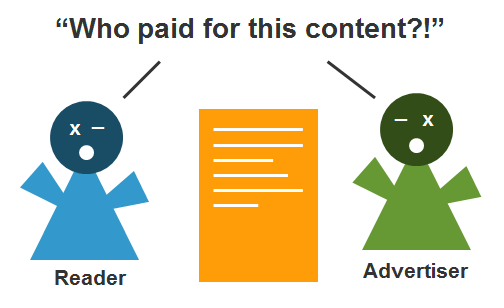“Who paid for this content?!”
Imagine this scenario:
Only days before the New Hampshire primaries, an article appears on the Des Moines Times-Courier website: “Candidate Chris Christie Hiding Past As Exotic Dancer,” and quickly goes viral, appearing in millions of Twitter streams, Facebook feeds, and email inboxes. Most people see the headline and shake their heads – “Politicians!” As a result, Christie loses the New Hampshire primary, even though the New York Times had revealed that the Des Moines article was a piece of native advertising paid for by a competitor. Christie’s campaign crumbles – from presidential favorite to footnote.
This is the kind of native advertising horror story that’s got old-school journalists hiding under their beds. They ask: “What happens when people don’t know who paid for the content?”
The example, and any horror story like it, is hyperbolic. It’s not going to happen. (And if politicians wanted to tar an opponent, there are far slicker ways to do it.)
In fact, native advertising’s been going on for decades. The original soap operas were native advertising. So are those boring “Invest in Tackyvania” inserts in The Economist.
The journalists and editors are worried about the skyrocketing popularity of native advertising online for a couple of reasons:
1) Online, it’s often not clear what’s a native ad and what isn’t.
2) They worry about how it reflects on their editorial content (and authority).
An Advertiser Paid For This Content
These issues would be solved if online publishers made it 100% clear – 24-point bold clear – that content paid for directly by an advertiser is just that. But there’s no incentive. They are paid for clicks or views. They earn more when native advertisements look like native editorial because more people will click on it.
That’s what you call a disconnect. A BIG disconnect.
Marketers are not best served when readers are fooled by a site to see their advertisement as editorial content. That is bad customer experience, in 24-point bold. The “get a click at all costs” mindset is not helping marketing leaders when they approach native advertising.
Marketer, repeat after me: “It’s in my interest to be 100% clear that my advertising content is paid-for advertising content, then build my proposition from there.” Our research shows that people are more than willing to read content from marketers, provided it’s useful, informative, or entertaining. That’s your bar.
Some readers shun paid-for advertising content. Using misleading or ambiguous labels to get them to click anyway is not a winning strategy. It only gives them an extra reason to despise the publication and advertiser. There’s not much to be gained there from a brand or sales perspective.
Some marketers and publishers aspire to a level of quality in paid-for advertising content that would warrant equal footing with editorial content – a worthy goal. If they succeed, then the content won’t suffer from being labeled as paid-for advertising. Readers will take it at face value, as they have for countless brands that are successful with content marketing.
Flipping “Who Paid For This?” On Its Head
So “who paid for this content?” shouldn’t be a question for the reader. It is, however, a big question for the marketer. I’ll explain.
In their drive to go native, marketers risk creating advertisements with zero value for their brand.
This can happen in two ways:
1) They don’t translate their advertisements to the native context (your latest product news won’t fly next to native editorial), or
2) Their brand disappears altogether in order to draw eyes to appealing content.
The first is a rookie mistake. The second’s a pitfall for even experienced marketers. Consider the kinds of “10 Things A Kitten Would Tell You If Kittens Could Talk” posts: People may click and people may like, but the brand disappears (sometimes literally). Anyone could have sponsored it.
This can also happen with expertly written journalistic pieces, such as a sponsored “Q&A with HotShot Independent Expert” post with no meaningful link to the brand behind it.
Advertising revenue has always subsidized publishers’ content, buying the right to insert their brand next to it. With native advertising, marketers risk paying directly for the content but not even getting their brand near it. They need to ask publishers (or, more appropriately, themselves): Who paid for this content?
Tying native advertising to brand value is a tricky proposition, and one that forces marketers to answer three tough questions:
1. What constitutes relevant and contextual insertion of our brand directly into a site’s native content?
2. What value are we able to get from the site on top of the specific insertion?
3. How does the native placement interact with everything else we’re doing (on that site and elsewhere)?
Not surprisingly, I’ll tell you that I am hard at work on a native advertising report that will give brands a way to answer those questions.
Tell me: What are your experiences producing or reading native advertising?
